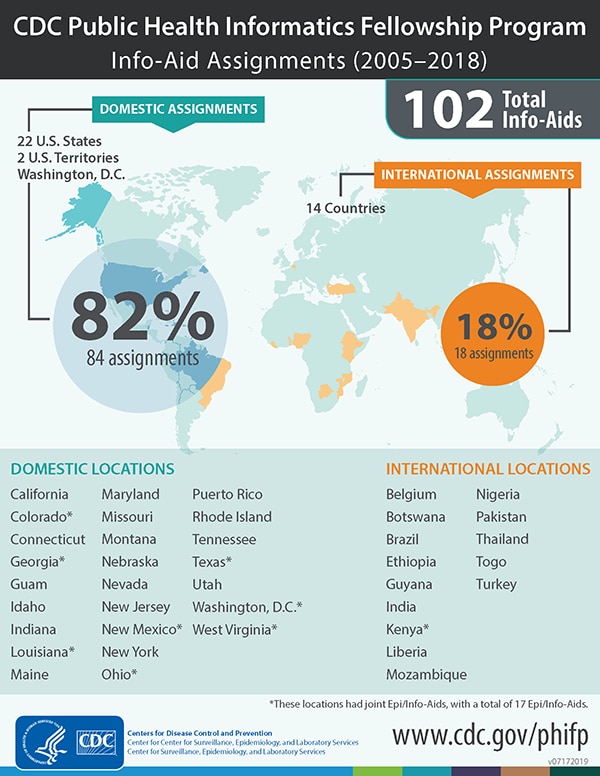Informatics Assistance (Info-Aids)
Domestic:
PHIFP fellows participated in 84 domestic requests in 22 U.S. states, 2 territories, and the District of Columbia.
International:
PHIFP fellows participated in 18 international requests in 14 countries.
In total, 17 responses were joint Epi/Info-Aids in eight domestic and international locations.

What is an Info-Aid?
Info-Aid Fact Sheet [608 KB, 1 page, 508]
An Informatics Aid (Info-Aid) is a mechanism that allows PHIFP fellows— CDC’s data detectives—to provide short-term technical assistance in the event of an urgent public health need for applied information science and technology. Informatics is critical as public health agencies rely on robust systems to get, transfer, and use data for core functions and services.
How long does an Info-Aid last?
Typically, an Info-Aid lasts between 120-160 hours (or can be extended if needed) depending on the complexity of the problem. After an Info-Aid, the requesting agency may continue collaboration for report writing, presentation, and follow-up projects.
Why request an Info-Aid?
Info-Aids can provide:
- Access to informatics expertise and technical support during public health emergencies.
- Strategic planning and informatics evaluation to design and develop, or overall improve public health information systems.
- Support of country-level health information systems for disease surveillance and outbreak response.
Who may request an Info-Aid?
The following agencies may request an Info-Aid:
- CDC/ATSDR and other federal agencies
- State and local health departments and public health agencies
- International health organizations
- Non-profit public health organizations
How is an Info-Aid requested?
The requesting agency should contact PHIFP@cdc.gov to request an Info-Aid. PHIFP program staff will provide additional details about the process.
What are examples of Info-Aids?
Since 2005, PHIFP fellows have participated in more than 102 Info-Aid requests. These include requests for assistance during public health responses to Hurricanes Katrina and Rita, Haiti earthquake, H1N1, Ebola, outbreaks of HIV traced to injection drug use in Indiana, Zika virus, and Seoul virus.
Some example activities of Info-Aids include:
- Designing and developing an information system to support a CDC outbreak investigation of HIV clusters by standardizing data collected from multiple sources and developing a dashboard to generate a live information feed.
- Facilitating the implementation and adoption of a health information system framework to standardize and integrate information systems across Kenya.
- Developing software requirements for a field training program’s management information system to monitor and evaluate the impact of the program.
- Establishing information systems for emergency operations to enhance acute watery diarrhea surveillance in Ethiopia.
“Public health informaticians are ‘bridgers.’ In an Info-Aid, it’s all about the data and it’s all about the relationships: these are not in isolation from each other. If you can bridge these two areas for the client, you have helped them succeed in improving health for their populations.”– Catherine Pepper (PHIFP Class of 2008)
“Info-Aids give you the opportunity to be exposed to different aspects of CDC and other organizations. Each Info-Aid experience pushes you to think critically about complex problems in a short period of time. You are ultimately pushed out of your comfort zone which creates opportunities for innovative and collaborative approaches to solving these complex problems.”- Brittani Harmon (PHIFP Class of 2016)